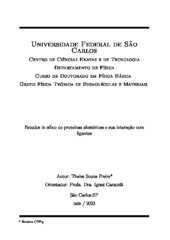| dc.contributor.author | Freire, Thales Souza | |
| dc.date.accessioned | 2023-04-17T19:11:12Z | |
| dc.date.available | 2023-04-17T19:11:12Z | |
| dc.date.issued | 2023-02-24 | |
| dc.identifier.citation | FREIRE, Thales Souza. Estudos in sı́lico de proteı́nas alostéricas e sua interação com ligantes. 2023. Tese (Doutorado em Física) – Universidade Federal de São Carlos, São Carlos, 2023. Disponível em: https://repositorio.ufscar.br/handle/ufscar/17782. | * |
| dc.identifier.uri | https://repositorio.ufscar.br/handle/ufscar/17782 | |
| dc.description.abstract | Allosteric proteins are extremely important for the regulation of several functions in
the organism, such as the transport of molecules through the blood and cell membranes,
as well as the phosphorylation of other proteins. In this context, the present work was
divided into the study of three proteins: Abelson Tyrosine Kinase (Abl1), Human Serum
Albumin (HSA) and FMS-Like Tyrosine Kinase 3 (FLT3). Each protein was studied
separately, using computational simulation methods, such as Classical Molecular Dynamics
and Molecular Docking. For Abl1 was studied the emergence of resistance to the drug
dasatinib upon mutations. Here, three mutations were simulated with the Free Energy
Perturbation method, where the difference in free energy variation between binding the
inhibitor to the native and mutant form of the enzyme was calculated, obtaining a good
agreement with experimental values. As for albumin, the change in conformation mediated
by the interaction with medium-chain fatty acids was studied. In this case, the well-
tempered Metadynamics method was used to facilitate the transition between states and
obtain the path of minimum free energy between one state and another, the results were
compatible with the experimental observations. As for FLT3, a study similar to that of
Abl1 was initiated, for the drug gilteritinib, however the dynamics of this enzyme proved
to be more complex than that of Abl1. As the theoretical results did not agree with the
experimental values, it was decided to investigate the effect of mutations on the activation
free energy profile, using Metadynamics with collective path variables. Such a tool made it
possible to reveal the effect of mutations on the activation dynamics, where the resistance
effect is partly due to a reduction in the enzyme activation barrier. In the three cases,
pure molecular dynamics alone was not able to give the desired information, making it
necessary to resort to enhanced sampling methods, such as free energy perturbation and
metadynamics, which showed to be efficient for the treated cases. | eng |
| dc.description.sponsorship | Conselho Nacional de Desenvolvimento Científico e Tecnológico (CNPq) | por |
| dc.language.iso | por | por |
| dc.publisher | Universidade Federal de São Carlos | por |
| dc.rights | Attribution 3.0 Brazil | * |
| dc.rights.uri | http://creativecommons.org/licenses/by/3.0/br/ | * |
| dc.subject | Alosteria | por |
| dc.subject | Proteı́nas | por |
| dc.subject | Enzimas | por |
| dc.subject | Dinâmica molecular | por |
| dc.subject | Metadi-nâmica | por |
| dc.subject | Perturbação de energia livre | por |
| dc.subject | Mutações | por |
| dc.subject | FLT3 | por |
| dc.subject | Abl1 | por |
| dc.subject | HSA | por |
| dc.title | Estudos in sı́lico de proteı́nas alostéricas e sua interação com ligantes | por |
| dc.title.alternative | In silico studies of allosteric proteins and their interaction with ligands | eng |
| dc.type | Tese | por |
| dc.contributor.advisor1 | Caracelli, Ignez | |
| dc.contributor.advisor1Lattes | http://lattes.cnpq.br/8956527354576143 | por |
| dc.description.resumo | Proteı́nas alostéricas são de extrema importância para a regulação de diversas
funções no organismo, como o transporte de moléculas pelo sangue e membranas celulares,
bem como a fosforilação de outras proteı́nas. Neste contexto, o presente trabalho se
dividiu no estudo de três proteı́nas: FMS-Like Tirosina Quinase 3 (Abl1), Albumina Sérica
Humana (HSA) e FMS-Like Tirosina Quinase 3 (FLT3). Cada proteı́na foi estudada
separadamente, com utilização de métodos de simulação computacional, como Dinâmica
Molecular Clássica e Docking Molecular. Para a Abl1 foi estudado o surgimento de
resistência para o medicamento dasatinib devido a mutações. Aqui, três mutações foram
simuladas com o método de Pertubação de Energia Livre, onde foi calculada a diferença
na variação de energia livre entre ligar o inibidor na forma nativa e mutante da enzima,
obtendo uma boa concordância com valores experimentais. Já para a albumina foi estudada
a mudança de conformação mediada pela interação com ácidos graxos de cadeia média.
Para isso, foi usada o método Metadinâmica bem temperada para facilitar a transição
entre os estados e obter caminho de mı́nima energia livre entre um estado e outro, com
resultados compatı́veis com as observações estruturais. Já para FLT3, iniciou-se um estudo
similar ao da Abl1, para o fármaco gilteritinib, porém a dinâmica desta enzima se mostrou
mais complexa do que a da Abl1. Como os resultados teóricos não concordavam com os
valores experimentais, optou-se por investigar o efeito das mutação no perfil de energia
livre de ativação, com utilização da Metadinâmica com variáveis coletivas de caminho.
Tal ferramenta possibilitou revelar o efeito das mutações na dinâmica de ativação, onde o
efeito de resistência é em parte devido a uma redução na barreira de ativação da enzima.
Nos três casos, apenas a dinâmica molecular pura não é capaz de obter as informações
desejadas, sendo necessário lançar mão de métodos de melhoramento de amostragem, como
a pertubação de energia livre e metadinâmica, os quais se mostraram eficientes para os
casos tratados. | por |
| dc.publisher.initials | UFSCar | por |
| dc.publisher.program | Programa de Pós-Graduação em Física - PPGF | por |
| dc.subject.cnpq | CIENCIAS EXATAS E DA TERRA::FISICA::FISICA GERAL::FISICA ESTATISTICA E TERMODINAMICA | por |
| dc.description.sponsorshipId | 141923/2019-9 | por |
| dc.publisher.address | Câmpus São Carlos | por |
| dc.contributor.authorlattes | http://lattes.cnpq.br/0320608221793070 | por |

